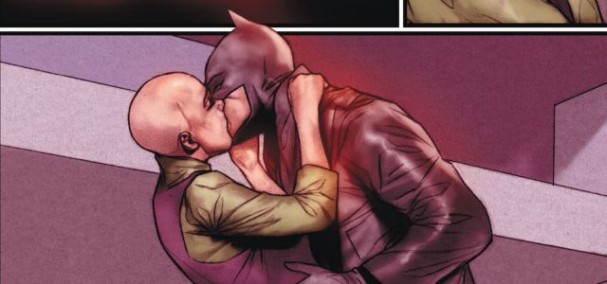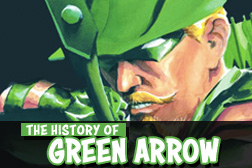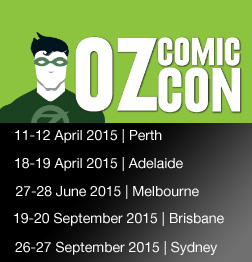It’s further down the rabbit hole as Grant Morrison’s meta dissection continues to reflect back on itself and examine the idea of the ‘superhero’.
Writer: Grant Morrison
Artists: Ben Oliver, Dan Brown
Letterer: Clem Robins
Publisher: DC Comics
Rating: 9/10
(Warning: review contains plot elements that may be considered minor spoilers)
“What’s your take on the whole comic books mmm-might be art thing?” It’s a question that Alexis Luthor, the genius daughter of Lex, asks Damien Wayne, the current Batman of Earth-16 (aka Earth-Me). From the very beginning of Grant Morrison’s The Multiversity, it’s questions like these that could be posed directly to the audience. Which is partly what The Multiversity: The Just is positing, setting its scene in a world where superheroes are pop cultural icons. What do costumed ‘heroes’ do in a world where super crime has already been defeated by their parents? More to the point, what else could comic books be than art when the ‘reality show’ fantasies of the costumed rich have replaced any form of progress.
The legacy of superhero parents has been explored before by DC, most notably in Kingdom Come (1996) by Mark Waid and Alex Ross, and more recently in Mark Millar and Frank Quitely’s Jupiter’s Legacy. Indeed, DC spent much of the 1990s handing the keys to dad’s car over to Kyle Rayners, Connor Hawkes, and Wally Wests of the world. Yet this world is far from Waid’s chaotic street brawls, or those aforementioned attempts to see if something new could be done with decades-old characters. The legacy that costumed heroes have left their children here is a world without crime, thanks largely to a network of Superman robots that patrol the Earth. Along with Wayne and Luthor, Chris Kent, Offspring, Megamorpho, Donna Troy, Arrowette, and others self-reflect in a perpetual state of apathy and arrested development. When one of their number commits suicide, it almost moves some of them to genuine emotion, and others to some kind of action.
Morrison has often discussed the dangers of trying to apply reality to comic book fiction. “Adults…struggle desperately with fiction, demanding constantly that it conform to the rules of everyday life,” he muses in Supergods. “The answer is obvious even to the smallest child: because it’s not real.” In the world of ‘Earth-Me’, the superheroes have won. Of course, superheroes always win, that’s what they do. The irony is that superheroes can also never completely win, because their entire purpose for being would cease to be (and naturally, make monthly publishing a little awkward). Which is exactly whereThe Multiversity: The Just comes in. They relive past glories as practice, creating elaborate historical recreations of bast battles, like the “Battle of Boston” or “Aqua-Crisis 2”, simply to keep themselves and their powers occupied.
Ben Oliver is an ideal choice of artist for this book. His painted style provides something close to the photorealism necessary to pull off this heightened drama. Character designs reflect the ego-driven aesthetic of the world, from Arrowette’s barely-there attire to the long black leather coat of Batman (which isn’t that far removed from Francesco Francavilla’s concept art for the pulp-inspired Batman ’72). It’s especially important in this chapter too, as the meta nature of the Multiverse becomes apparent as comic books start bleeding into other worlds. Earth-16’s characters hold in their hands copies of the cursed Ultra Comics, last month’s The Multiversity: The Society of Super-Heroes: Conquerors of the Counter-World #1 and, of course, The Multiversity #1. It all seamlessly blends into the one visual style, with Oliver and Dan Brown’s colour scheme providing a similar otherworldly glow to that of Kingdom Come.
The Multiversity: The Just isn’t just a clever spin on existing characters, but an examination of the medium itself. Superman talks of his team-up with The Sandman. “The Sandman?” asks Batman. “Neil Gaim’s Sandman?” The unstated question is that if superhero worlds exist because we tell their stories, then who is telling the story that wills us into reality? Like the previous chapters in this series, this issue ends on one hell of a cliffhanger, at the very moment the spell of apathy is broken and our heroes once again have a cause to fight for. It’s all pieces of a larger puzzle, one that we can’t wait to see fully formed when the final chapter drops.
Agree or disagree? Got a comment? Start a conversation below, or take it with you on Behind the Panel’s Facebook and Twitter!
If you are an iTunes user, subscribe to our weekly podcast free here and please leave us feedback. That’s how we get more attention! Go do it now. We’ll be waiting right here.












